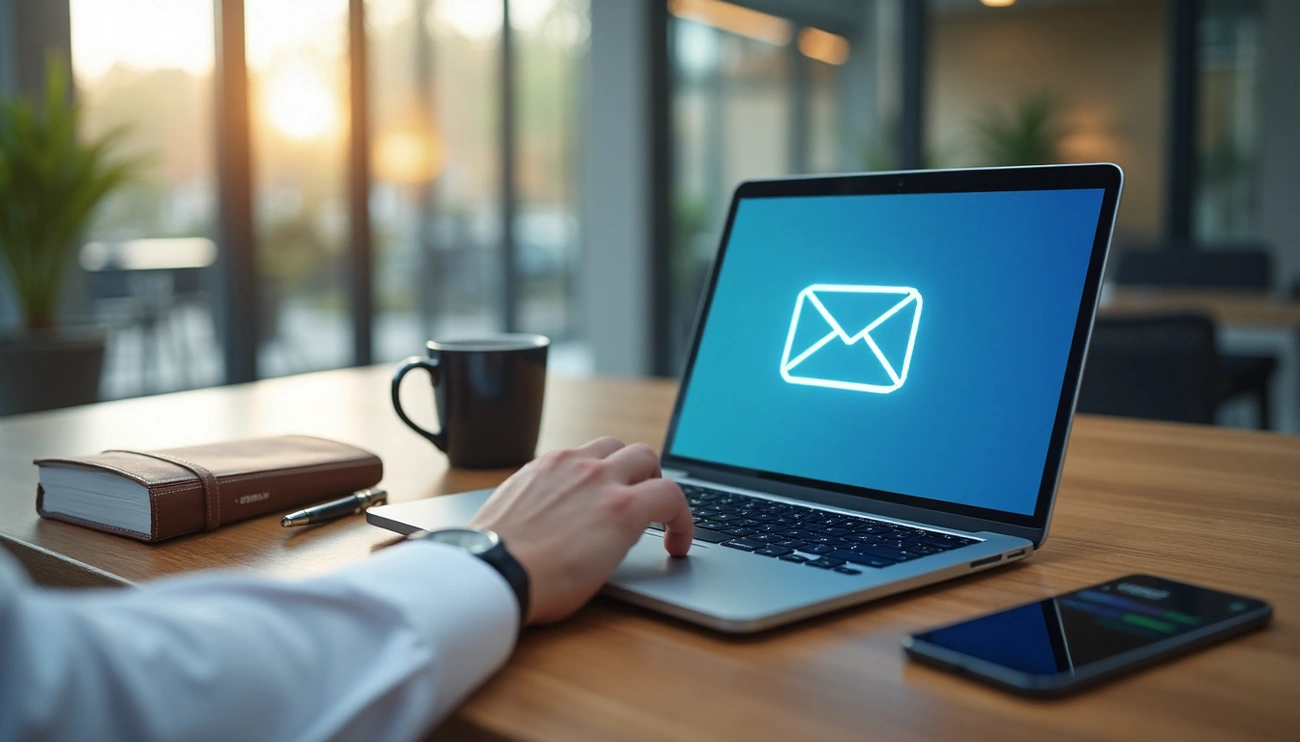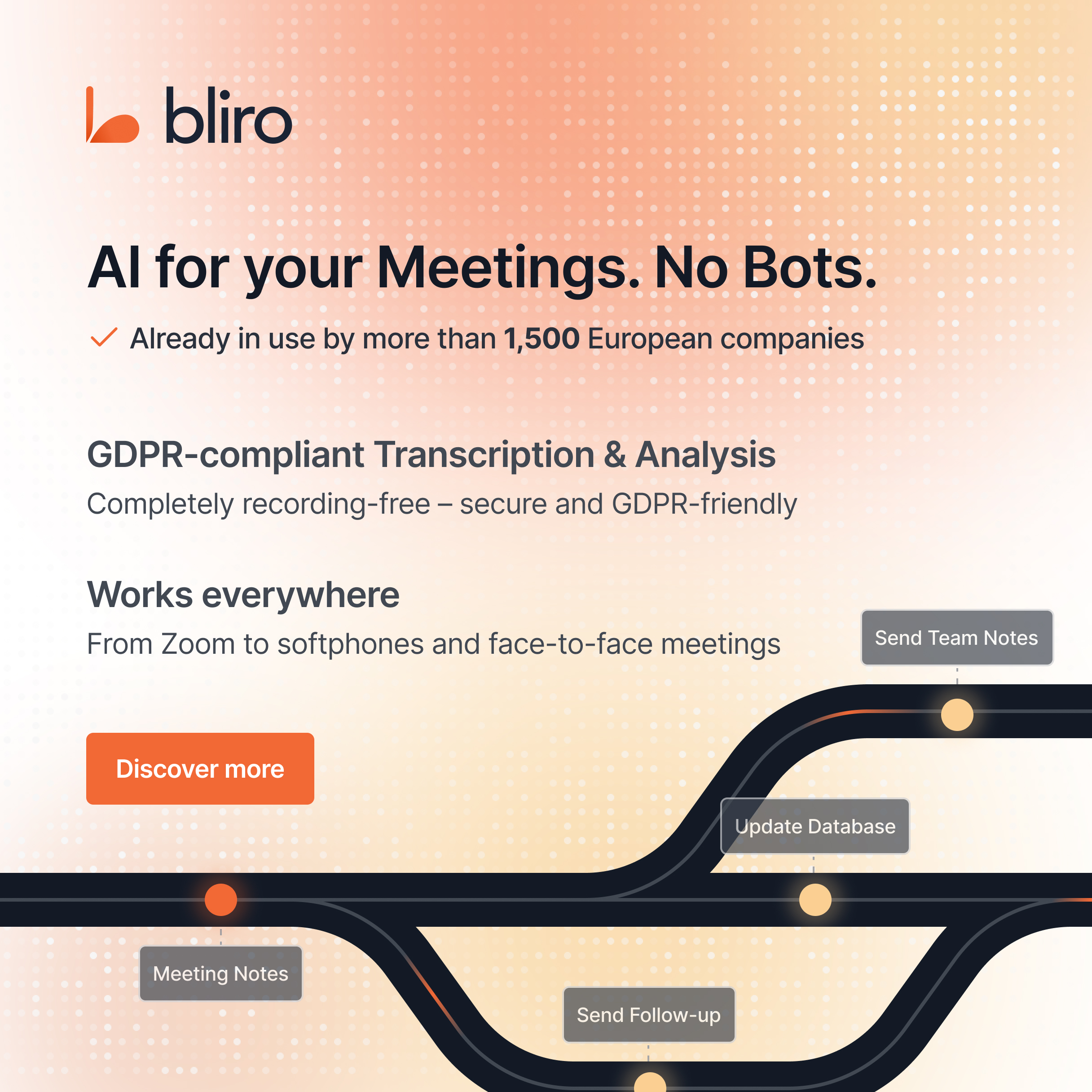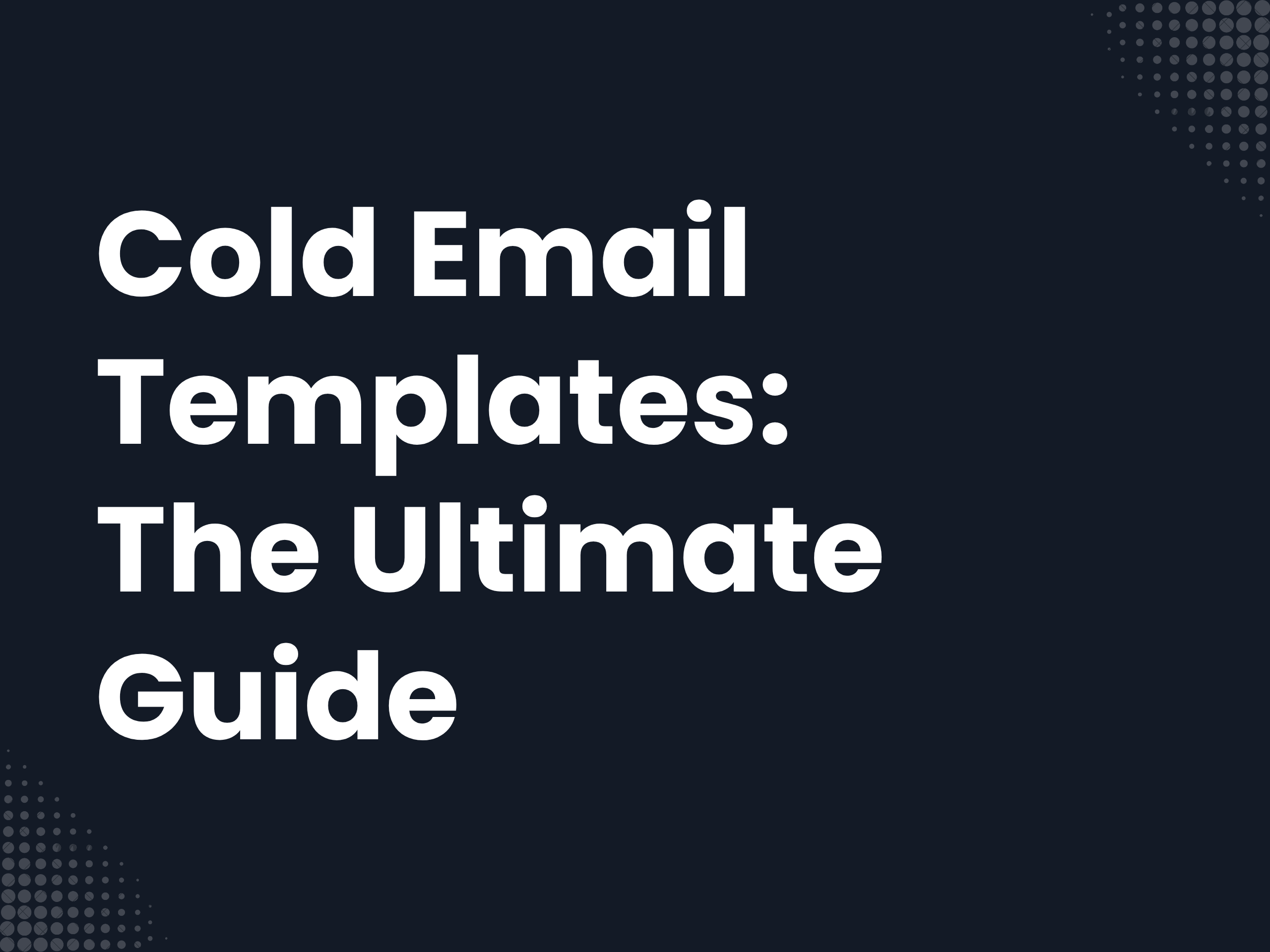In fact, 80% of people prefer to be contacted by salespeople via email rather than through other channels. Although 347 billion emails are sent every day, could outreach via email is still one of the most effective tools in B2B sales.
The figures speak for themselves: While the average response rate to cold emails is just 1%, well-thought-out campaigns have an average response rate of over 30%.
In this hands-on guide, you'll learn everything you need to know for successful cold mail in 2025 - from proven templates and best practices to common mistakes. We'll also show you how modern tools like Bliro with Conversation Intelligence can optimize your cold email strategy by helping you gain valuable insights from every customer interaction and maximize your response rate.
What is cold emailing and why is it still relevant in 2025?
In the digital business environment, companies are constantly looking for cost-effective and effective methods to attract new customers. One technique that has proven effective despite numerous changes in the marketing landscape is cold emailing. But what exactly is behind this term and why is this method also relevant in 2025?
Definition and cold email meaning
Cold mailing describes the process of sending an email to potential customers with whom there was no direct contact before. In other words, it is an unsolicited email that is sent to a recipient who has no previous relationship or connection with the sender. In contrast to spam messages, cold emails are usually personalized and tailored to the specific needs or interests of recipients.
The main purpose Cold emails consist of creating new connections, making contacts for networking, or generating leads for sales. The effectiveness of a cold email is measured by its ability to address the recipient and receive an answer. Cold emailing is therefore a targeted approach for generating leads and arousing interest in products or services.
Although the term “cold calling” may seem daunting at first, cold emailing is a legitimate way to find customers and build relationships. It is crucial that the message is relevant and appealing in order to achieve a positive response.
Cold email vs. cold calling
When deciding between cold emailing and Cold Calling Are there significant differences to consider. According to studies, prefer 8 out of 10 potential customers Emails versus phone calls, as this method is perceived as less intrusive.
Compared to cold calling, cold emailing offers the following advantages:
- Better scalability: Emails are easier to scale - you can send multiple emails during a single phone call.
- More cost-effective: Cold emailing remains a cost-effective option compared to other sales channels.
- Easier tracking: Email systems make it possible to track important statistics such as open rates, response rates, and conversion rates.
- Visualization possible: You can attach visually appealing and informative content to a sales email.
However, cold calling also has its strengths. Cold calls are more personal and allow immediate answers and direct feedback. You can also adjust your strategy to meet a potential customer's needs during the conversation.
The choice between these two methods should not be considered “either/or.” Instead, a combination of both approaches can lead to optimal results. Using conversation intelligence from Bliro you can also gain valuable insights from every customer conversation.
Is cold emailing effective in sales?
The effectiveness of cold emailing in sales is proven by numerous data. Studies show that well-formulated cold emails achieve a significantly higher response rate than impersonal mass emails. The average response rate for a cold email is between 1% and 5%, depending on the recipient and especially on the personalization of the content.
Contrary to the assumption that cold emailing is outdated in the modern digital landscape, current data confirm the opposite. In 2025, prefer 61% of decision makers Cold emails versus LinkedIn (29%) and cold calls (10%). Companies that use cold emailing as part of their sales strategy often achieve better conversion rates in the B2B sector.
However, the effectiveness of cold email depends on various factors:
- Target group analysis: A precise target group analysis is crucial for success.
- Personalization: Smaller campaigns with 50 recipients or less achieve an average response rate of 5.8%, compared to 2.1% for campaigns with 1000+ recipients.
- Follow-ups: Campaigns with follow-up emails have a higher average response rate (4.9%) than campaigns without follow-ups (3%).
- Clarity and relevance: Cold emails can be effective if they are highly targeted and offer a clear value proposition.
Despite stricter spam filters and more skeptical buyers, there are still senders who are successful with cold emails. The key is quality rather than quantity - no automation can make up for poor targeting or generic messages.
At a time when other channels are becoming increasingly expensive and crowded, cold emailing remains an effective way to reach decision makers directly.

The 8 Best Cold Email Templates for 2025
With the right templates, you can significantly increase your chances of success in cold emailing. While the average response rate for cold calling emails is just 1% if so, well-formulated cold emails can achieve a significantly higher response rate. Below, we present eight proven templates that have been proven to work and help you maximize the response rate of your campaigns.
1. Introductory email
The introductory email is used to present you, your company and your offer to a potential customer. It is important not to provide too many details, but to provide a clear added value. Key elements:
- Brief presentation (1-2 sentences)
- Clear value proposition
- Low-threshold final question
Template:
Subject: [first name], a quick impulse for you
Hi [first name],
I am [your name] from [company] - we help [target group] to work much more efficiently through [solution/advantage].
For example, we were recently able to implement [relevant example] - maybe that is also exciting for your team?
Who would be the right contact for you for this topic?
Best regards
[name]
Particularly effective: First, ask who the right person to contact is, instead of asking for a call right away.
2. Personalized cold email
This template shows the recipient that you understand their business and are closely following market developments. Personalized emails don't have to be overly individual, but they should include enough detail to show that it's not a generic message.
Template:
Subject: Particularly relevant for [role] at [company] right now?
Hi [first name],
As a [role] at [company], you probably know the challenge, [relevant problem statement].
We are already working with teams in your industry (e.g. [customer example]) and are specifically helping [concrete benefits, such as “shortening sales cycles”].
Is that an issue for you too? Then I look forward to hearing from you.
Kind regards
[name]
Mentioning the target person's profession right at the beginning of the email proves that you're talking to the right person. Smaller, personalized campaigns with 50 recipients or less achieve a average response rate of 5.8%, compared to 2.1% for large campaigns with 1000+ recipients.
3. Before-and-after bridge template
This technique uses the two most powerful human motivators: pain and joy. The structure follows a clear structure:
- Before: Describe the potential customer's current situation or problem
- After: Show what the future could look like once the problem is solved
- Bridge: Explain how your product or service can make this change
Template (using Bliro as an example):
Subject: From “too many tools” to “everything in one workflow”
Hi [first name],
Many of our customers were faced with the challenge of distributing their meeting documentation via notes, CRM, and Slack.
Today, they automatically record everything in a central workflow - without manual rework.
Our solution makes just that possible. Would that be interesting for your team?
Best regards
[name]
To use this template successfully, you'll need to identify the prospect's challenge and outline a clear solution.
4. Useful content as a start
Not every cold email has to be a direct sales conversation. Sometimes it's more effective to add value by sharing a useful resource. This could be a white paper, an infographic, or an informative blog post.
Template:
Subject: [first name], this checklist might be useful for you
Hi [first name],
I came across your area and thought this short guide might be interesting for you:
[Title & link to white paper, blog, etc.]
We help teams use their meeting insights before they disappear into the note-taking chaos.
I would be happy to hear whether this is currently relevant to you!
Best regards
[name]
This method is great for building a relationship, especially if you're cold calling.
5. Social proof & reference template
Social proof is a powerful psychological principle that makes people more likely to perform an action when they see others doing it too. A social proof template can include:
- Name respected companies that are already customers
- Direct quotes from satisfied customers
- Case studies or awards
- Impressive user base statistics
Template:
Subject: What [known customer] achieved with [your tool]
Hi [first name],
[Reference customer] was able to make their sales meetings 40% more efficient with our solution.
We work with companies such as [Name 1], [Name 2] and [Name 3] to automatically capture meeting notes and integrate them with CRM workflows.
Would you be interested in a short demo?
Best regards
[name]
This template works particularly well when potential customers are skeptical or uncertain about the ROI. Studies show that emails with social proof can significantly improve response rates.
6. Competitor comparison
With this template, you're targeting potential customers who are already using your competitors' products. The challenge is to be careful without discrediting your competitors.
Template:
Subject: A fresh look at your current solution?
Hi [first name],
We are currently talking to many [target group] who work with [competitors] - and are looking for easier ways to solve [specific tasks].
[Your product] offers [name USP, e.g. “direct CRM integration without additional tools”].
If you are interested in a comparison, I would be happy to show you.
Best regards
[name]
Show why your product is more suitable for the potential customer, for example by directly comparing specific features or by pointing out your unique selling points.
7. Demo request template
This template is suitable for clearly describing your product or service and showing how the recipient can benefit from it. Sharing a short sample video is often a fantastic way to create a compelling demo request.
Template:
Subject: 10-minute demo: How to save sales teams 8 hours a week
Hi [first name],
I wanted to ask if you'd like to take a quick look at our solution - it helps sales and CS teams automatically create meeting summaries & action items.
In a short demo, I'll show:
✔ How to get rid of manual notes
✔ How the CRM is automatically filled
✔ How teams derive coaching & insights from this
Would a 15-minute slot be possible for you this week or next?
Best regards
[name]
At the same time, you should explain what the agenda of the conversation is so that the recipient understands what it's about.
8. Follow-up template with separation
The so-called “breakup email” is one of the most effective follow-up emails you can use with unresponsive prospects. According to sales experts, this type of email gets a 33% response rate.
Template:
Subject: Last try - should I remove you from my mailing list?
Hi [first name],
I've contacted you a few times in the last few weeks, but maybe our topic isn't relevant to you right now.
If so, I would be happy to receive a brief response - otherwise I would be happy to remove you from my mailing list.
All the best & thanks for your open feedback,
[name]
In this last email, you let the recipient know that you won't get back to you afterwards. This creates gentle pressure and gives the prospective customer one last chance to answer. You'll often get answers from people who are interested but haven't had time to look into them yet.
Cold email best practices: What really works?
Successful cold emails are based on best practices that have been proven to increase opening and response rates. While beginners often only get a 1-5% response rate, experienced users reach out with well-thought-out campaigns Response rates of up to 22.37%. The difference is not in luck, but in the consistent application of the following Best Practices.
Target group segmentation
Target group segmentation is a decisive success factor in cold emailing. By dividing potential recipients into relevant segments, you can send personalized emails that are tailored exactly to their needs.
A strategic approach includes:
- Data analysis: Investigation of recipients' behavior and interests for categorization
- Targeted communication: Segmented communication leads to significantly higher response rates than mass emails
Subject lines that are opened
The subject line decisively determines whether an email is opened at all. According to data, only about 24% the recipient of sales emails. However, a well-designed subject line can increase the opening rate by up to 50%.
The following applies to effective subject lines:
- Optimum length: 6-10 words or maximum 49 characters
- Keywords at the beginning: Important statements should be at the beginning
- Personalization: Emails with personalized subject lines have 26% higher open rates
When wording, you should sound human and convey a clear benefit without appearing “salesy.” Avoid capital letters, excessive punctuation, or clickbait phrases.
Relevant content instead of advertising
The content of a cold email must focus on the recipient, not on your product or service. The average reading time for emails is just 13.4 seconds - during this time, you need to be convincing.The following elements make your content relevant:
- Show empathy: Through signals that express genuine interest in the interlocutor
- Address needs: Define problems and offer concrete solutions
- Add value: share useful information or resources
The aim should not be immediate sales, but an answer that enables a deeper exchange.
Stay short and clear
Conciseness is a key success factor when it comes to cold emails. The optimal length is between 50-125 words - that's all you need to spark interest and start a conversation.
For maximum clarity:
- Be brief and concise to quickly convey the most important content
- Use the PAS method: Identify a problem, show sympathy, offer a solution
- Include a clear call to action (CTA) that defines the next step
Less is more - hardly anyone would read a long email from a stranger. Respect your prospects' time and get straight to the point.
Consistent follow-up
Most responses to cold emails don't come after the first message, but after the follow-ups. If you stop after the first email, you'll only get an average response rate of 4.5%. With systematic reworking, you can achieve up to 20%.
The optimal follow-up strategy:
- Quantity: 4-9 follow-ups are ideal
- Time interval: 2-5 days between messages
- Added value: Each follow-up email should offer new information or perspectives
Avoid guilt-ridden phrases like “I just wanted to ask” and focus instead on the added value for the recipient.

The most common cold mailing mistakes and how to avoid them
Despite all strategies and templates, many cold email campaigns fail due to avoidable mistakes. Yet companies often repeat the same mistakes.
Spam words and formatting errors
Specific words and formatting trigger automatically spam filter. Excessive capital letters, too many exclamation marks, and certain trigger words are particularly critical. You should also avoid excessive emojis and special characters. Microsoft, for example, filters emails with the terms “advertising,” “!” automatically as spam when combined with “$” or “free” and “$$”
Lack of context
Without sufficient context elements, the recipient won't be able to categorize your message. This leads to mistrust. Always explain who you are, where you're from and what the reason for your message is. Many senders focus too much on their own offering instead of showing how they can help the recipient.
Wrong tools or return address
Choosing the right shipping tool is critical. Newsletter tools like Mailchimp are for cold emails unsuited. They send emails on a large scale and instantly, while good cold email software staggeres the delivery time to simulate human behavior. In addition, always use your official company domain instead of external email service providers.
Missing signature or unsubscribe link
A professional signature performs two important functions: It gives the recipient information about you and shows spam filters that you are a legitimate sender. However, the signature shouldn't be too long - if it's longer than your email, it's likely won't be read.
The following applies to the unsubscribe link: In the B2B sector, a classic unsubscribe link is often inappropriate because it makes the email look more impersonal. Instead, offer an easy way to stop receiving messages, such as by saying, “Let me know if you're not interested in this offer.”
Tools and automation: How to scale your cold email strategy
The right technology is key to scaling your cold email strategy. With the right tools, you can automate processes while maintaining the personalization that is essential for successful campaigns.
Comparing cold email tools
There are various platforms available for effective cold emailing, which differ in their range of functions and prices:
- Deliverability specialists: Woodpecker and Smartlead offer automatic email warm-up, which improves inbox placement and bypasses spam filters.
- Personalization champions: Lemlist and Mailshake use AI to create tailored messages and increase response rates.
- All-in-one solutions: Close.io and HubSpot combine CRM with cold emailing under one roof.
It is remarkable that only about 35% of available tools offer automatic email warm-up - an important feature that even large providers such as HubSpot, Apollo and Outreach have not yet integrated.

How Bliro helps with conversational intelligence
Bliro goes beyond classic cold mailing by transcribing and summarizing all your conversations with customers, whether via online meeting or on-site conversations. The tool automatically creates notes from customer conversations, sends follow-ups and updates databases - saving you up to 8 hours a week. In addition:
- Improve your team through AI coaching and best practice sharing (22% higher completion rates)
- Provides valuable customer insights for better decisions
- Integrates seamlessly with your existing systems such as Salesforce, Hubspot, or Microsoft Teams
Automate follow-ups
Retaliations are crucial - 80% of all deals occur only after the third contact attempt. Automated sequences increase the average response rate from 3% (excluding follow-ups) to 4.9% (with follow-ups). A few tried and tested patterns:
- Day 1: First email with presentation and value proposition
- Day 2: First follow-up at a different time of day
- Day 5: Second follow-up with another CTA
- Day 8-10: Third follow-up, possibly as a breakup email
Conclusion
Cold emailing will remain a powerful tool in B2B sales even in 2025 if you use the right strategies. The figures speak for themselves: 80% opening rate and 20% response rate are certainly achievable, while classic mass emails often stagnate at 1%. The decisive difference lies not in luck, but in the consistent application of proven methods.
Personalization is undoubtedly paramount. Smaller, targeted campaigns with a maximum of 50 recipients demonstrably achieve better results than large, impersonal mass mailings. At the same time, you should be brief and concise - no one reads long emails from strangers.
Systematic follow-up appears particularly important. In fact, 80% of all deals only arise after the third contact attempt. Without follow-ups, you're wasting valuable potential and limiting your response rate to an average of 3% instead of a possible 22%.
Bliros Conversation Intelligence can significantly optimize this entire process. The tool analyses customer interactions, automates follow-ups, and provides valuable insights for continuous improvement. This not only saves you time, but also measurably increases your success rates.
Use the presented templates, best practices, and tools to optimize your cold email strategy. Remember: The key isn't the quantity, but the quality of your messages.








